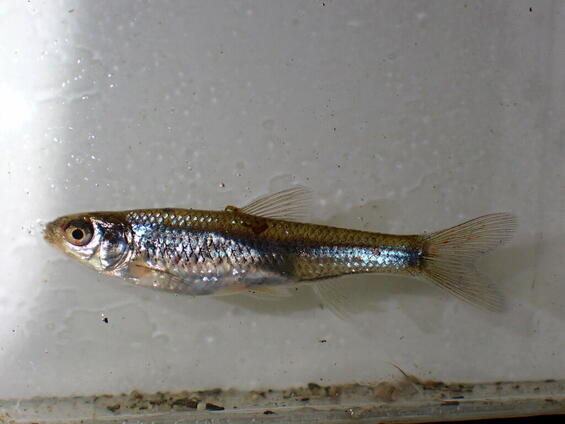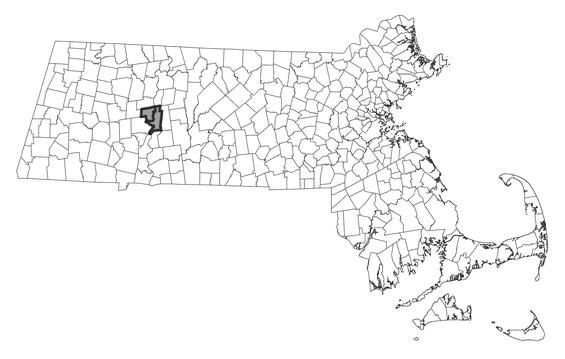- Scientific name: Hybognathus regius
- Species of Greatest Conservation Need (MA State Wildlife Action Plan)
- Special Concern (MA Endangered Species Act)
Description

Eastern silvery minnow (Hybognathus regius)
The eastern silvery minnow is a rather stout shiner generally around 76 to 127 mm (~3-5 in) in length. It can best be distinguished by the following combination of characters: a small, slightly subterminal mouth, a lower jaw with a fleshy knob at the tip, a black peritoneum (lining of body cavity), a long, coiled intestine, a complete lateral line, and 38-40 lateral line scales. The black peritoneum and the coiled intestine can sometimes be seen through the belly wall. This species is silvery in color and lacks distinctive color patterns.
Life cycle and behavior

Little is known about this species in Massachusetts and information derives from populations elsewhere in its range. The eastern silvery minnow has a life span of only about 3 years and becomes sexually mature in their second year. Spawning occurs in April and May when water temperatures are between 10 and 20°C (50-68°F). Spawning takes place in well-vegetated backwaters or slow-moving, lower reaches of tributary streams. Spawning is communal and non-adhesive eggs sink when laid over bottom ooze. Spawning only occurs during daylight hours. Eggs hatch in only 6 to 7 days in water temperatures of 13 to 20°C (55-68°F). By early August, young of the year can reach 40 mm (1.5 in) in length. No detailed food studies have been conducted, but algae and organic matter filtered from benthic organic matter have been found in their stomachs. Processing of organic matter is achieved by the specialized pharyngeal apparatus (bony toothlike projections on the fifth gill arch) and long coiled intestine. A variety of larger fish likely feed on this species, especially those in similar habitats such as chain pickerel and bass species.
Distribution and abundance
The eastern silvery minnow range extends from Georgia north along the Atlantic slope to Quebec and Ontario. The species has been recorded in Maine (introduced via bait bucket), Vermont, New Hampshire, and Massachusetts. In Massachusetts, the species occurs in the Connecticut River and has not been documented in over 20 years.
The status of eastern silvery minnow in Massachusetts remains uncertain. The species is listed as special concern in Massachusetts. As with all species listed in Massachusetts, individuals are protected from take (collecting, killing, etc.) and sale under the Massachusetts Endangered Species Act.

Distribution in Massachusetts. 2000-2025. Based on records in the Natural Heritage Database.
Habitat
The eastern silvery minnow is found in shallow areas of large, slow-moving rivers over substrates of sand and mud or sand and gravel. They are often found in habitats such as oxbows and quiet pools with aquatic vegetation beds.
Healthy habitats are vital for supporting native wildlife and plants. Explore habitats and learn about conservation and restoration in Massachusetts.
Threats
Habitat alterations due to increased turbidity, erosion and sedimentation, flow alterations, and water pollution are major threats to the eastern silvery minnow. Increased turbidity and sedimentation can impact the growth of aquatic vegetation used by this species. In addition, sedimentation may reduce benthic organic matter food availability. Flow alterations may degrade backwater areas critical for spawning.
Survey and monitoring
Routine fish community sampling has failed to detect eastern silvery minnow within the Connecticut River in more recent years, but targeted sampling, which was responsible for the most recent collection, has not been repeated.
Management
Management for this species focuses on habitat protection and restoration such as improvements to streamflow at dam operations, and floodplain and streambank restoration.
Research needs
Targeted survey effort (e.g., eDNA, physical surveys) is needed to detect potential extant viable populations in the Connecticut River. Seines are most effective for this species in the summer months. If present, population-level genetic analysis is warranted to estimate its genetic diversity and viability and compare to other populations within its range. Efforts will provide an update on the species’ status.
References
Hartel, K.E., Halliwell, D.B., Launer, A.E. Inland Fishes of Massachusetts. Lincoln, MA: Massachusetts Audubon Society, 2002.
Contact
| Date published: | April 11, 2025 |
|---|